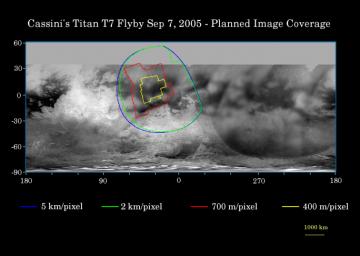This map of Titan's surface illustrates the regions that will be imaged by Cassini during the spacecraft's close flyby of Titan on Sept. 7, 2005. At closest approach, the spacecraft is expected to pass approximately 1,075 kilometers (670 miles) above the moon's surface. This is Cassini's eighth flyby of Titan out of 45 flybys planned in the four-year tour.
The colored lines delineate the regions that will be imaged at differing resolutions.
Zooming-in closer to Titan than during its previous pass two weeks earlier, Cassini camera coverage again focuses on the region known informally as "the H." Some of the narrow-angle camera images Cassini takes during this close flyby will be composited into high-resolution mosaics, similar to PIA06222.
This encounter also should provide an excellent view of Bazaruto Facula and its central 80-kilometer-wide (50-mile) crater, seen in PIA06234.
The map shows only brightness variations on Titan's surface (the illumination is such that there are no shadows and no shading due to topographic variations). Previous observations indicate that due to Titan's thick, hazy atmosphere, the sizes of surface features that can be resolved are a few to five times larger than the actual pixel scale labeled on the map.
The images for this global map were obtained using a narrow band filter centered at 938 nanometers - a near-infrared wavelength (invisible to the human eye) at which light can penetrate Titan's atmosphere to reach the surface and return through the atmosphere to be detected by the camera. The images have been processed to enhance surface details.
The Cassini-Huygens mission is a cooperative project of NASA, the European Space Agency and the Italian Space Agency. The Jet Propulsion Laboratory, a division of the California Institute of Technology in Pasadena, manages the mission for NASA's Science Mission Directorate, Washington, D.C. The Cassini orbiter was designed, developed and assembled at JPL.
For more information about the Cassini-Huygens mission visit http://www.nasa.gov/cassini and http://saturn.jpl.nasa.gov

 Planetary Data System
Planetary Data System












